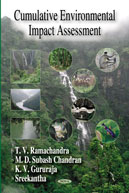| Sahyadri Conservation Series: 23 |
ENVIS Technical Report: 53, May 2013 |
 |
Status of Forest in Shimoga District, Karnataka |
 |
1Energy and Wetlands Research Group, Centre for Ecological Sciences, Indian Institute of Science, Bangalore – 560012, India.
2Member, Western Ghats Task Force, Government of Karnataka, 3Member, Karnataka Biodiversity Board, Government of Karnataka
*Corresponding author: cestvr@ces.iisc.ac.in
PUBLICATIONS
- Ramachandra T.V., Subash Chandran M D., Gururaja K V and Sreekantha, 2007. Cumulative Environmental Impact Assessment, Nova Science Publishers, New York.
- Ali, Sameer, G. R. Rao, Divakar K. Mesta, Sreekantha, Mukri Vishnu, M. D. SubashChandran, K. V. Gururaja, N. V. Joshi, and T. V. Ramachandra. Ecological Status of Sharavathi Valley Wildlife Sanctuary. Prism Books Pvt Ltd., Bangalore, 2007
- Gururaja, K.V., Aravind, N.A., Sameer Ali, Ramachandra, T.V., Velavan, T.P., Krishnakumar, V.and Aggarwal, R.K., 2007. A New Frog Species from the Central Western Ghats of India,and its Phylogenetic Position, Zoological Science, 24:525-534.
- Sreekantha, SubashChandran M.D., Mesta D.K., Rao G.R., Gururaja K.V., Ramachandra T.V. Fish Diversity in Relation to Landscape and Vegetation in Central Western Ghats, India. Curr.Sci.,2007: 92(11):1592-1603. Gururaja, K.V. and Ramachandra, T.V., 2006. Developmental mode in white-nosed shrub frog Philatus cf. leucorhinus, Current Science, 90(3): 450-454.
- Gururaja, K.V. and Ramachandra, T.V. 2006. Pedostibestuberculosus Advertisement Calls and Distribution, Herpetological Review, 2006, 37(1):75-76
- Sreekantha, Gururaja, K.V., Remadevi, K., Indra T.J. and Ramachandra T.V., 2006. Two new species of the genus SchisturaMcclelland (Cypriniformes: Balitoridae) from Western Ghats, India., Zoos’ Print Journal, 211(4): 2211-2216
- Sreekantha and Ramachandra T.V. 2005. Fish diversity in Linganamakki reservoir, Sharavathi river, Ecology, Environment and Conservation, 11(3-4): 337-348
- Ali, s., Gururaja K.V. and Ramachandra, T.V. 2005. Schisturanilgiriensis (Menon) in Sharavathi river Basin Western Ghats, Karnataka, ZOOS’ Print Journal, 20 (2): 1784-1785
- Rao G.R., SubashChandran M.D. and Ramachandra T.V., 2005. Habitat approach for conservation of herbs, shrubs and climbers in the Sharavathi River Basin, The Indian Forester, 131 (7): 885-900
- Ramachandra T.V., SubhashChandran M.D., Sreekantha, Diwakar Mesta, Rao G.R. and Sameer Ali. 2004. Cumulative Impact Assessment in the Sharavathi River Basin, International Journal of Environment and Development, 1(1): 113-135.
- Ramachandra, T.V. and Sreekantha, 2006. Conservation values of wetlands, Pollution Research 25(1):61-66.
- Ramachandra T.V. and Ajay N., 2007. Ants habitat mapping using remote sensing and GIS, Eco_chronicle 2(3): 115-121
- SubashChandran M.D., Mesta D.K., Rao G.R., Sameer Ali, Gururaja K.V. and Ramachandra T.V. 2008. Discovery of two critically endangered tree species and issues related to relic forests of the Western Ghats, The Open Conservation Biology Journal, 2008, 2, 1-8. http://www.bentham.org/open/toconsbj/openaccess2.htm, doi: 10.2174/1874839200802010001
- Desai, S. R., Subash Chandran M. D. and Ramachandra, T. V., 2008. Phytoplankton Diversity in Sharavati River Basin, Central Western Ghats(August 11, 2008). The Icfai University Journal of Soil and Water Sciences, I(1): 7-66 Available at SSRN: http://ssrn.com/abstract=1216302
- Sreekantha, K. V., Gururaja and T. V. Ramachandra, 2008. Nestedness pattern in freshwater fishes of the Western Ghats: an indication of stream islands along riverscapes, Current Science, 95 (12):1707-1714.
Cumulative Environmental Impact Assessment
Abstract: An ecosystem is a complex of interconnected living organisms inhabiting a particular area or unit of space, together with their environment and all their interrelationships and relationships with the environment having a well-maintained ecological processes and interactions. It is characterized by the abundance of individual species populations; interspecies relationships; activity of organisms; physical and chemical characteristics of environment; flows of matter, energy, and information; and description of changes of these parameters with time. Hence, its surroundings can be categorised into physical and biological environment, which are self-defined, self-maintained and self-sustained dynamic natural systems. The physical environment comprises of lithosphere, hydrosphere and atmosphere, while the living beings in the biosphere constitute biological environment. The biosphere contains many delicate biological processes that have taken billions of years to evolve and there is a natural equilibrium for life sustaining processes dependent on relatively slow rates of recycling. These natural processes as well as resources are being over driven by human activities to meet the growing demands of the population. These developmental activities by humans ignoring the ecosystems and functional aspects are instrumental in bringing about irreversible changes in the ecosystem and their environment.
The concern now is on the rise for the changes due to human induced activities that are proving detrimental, as it has exceeded the recycling rates of natural processes, which are altering the very nature of the environment. These changes are drastic, both to the environment and its inhabitants alike. Under such circumstances, it is necessary to do a retrospective analysis of the present situation to identify the degree of seriousness of different kinds of anthropogenic activities on the environment, plausible measures to curb further damaging to environment and better ways to live in harmony with the environment.
|
|


